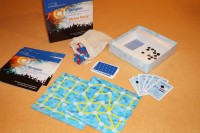By Michael Banks
From a particle collider made of LEGO to physicists taking on the ice-bucket challenge, physics has had its fair share of interesting stories this year. Here is our pick of the 10 best, in chronological order.
The designated survivor
The nuclear physicist and US energy secretary Ernest Moniz may be 14th in the US presidential line of succession, but if something really terrible had happened in late January, then he might have found himself leading the world’s biggest economy. That is because Moniz was appointed the “designated survivor” while US president Barack Obama delivered his State of the Union address earlier this year.
The speech, which is attended by the country’s top leaders, including the vice-president, members of the US cabinet and Supreme Court justices, is where US presidents outline their legislative agenda for the coming year. A designated survivor is a member of the cabinet who stays at a distant, secure and undisclosed location during the address to maintain continuity of government in the event of a natural disaster or terrorist attack that ends up killing officials in the presidential line of succession.
Of course, nothing untoward happened, so Moniz did not find himself as leader of the world’s richest nation. The question remains, however, where was Moniz during the speech? Having emerged with his trademark flowing grey hair intact, at least we know Moniz wasn’t at the hairdressers.
Spin-glass: the game
Alexander Hartmann is determined to make condensed-matter physics fun. The University of Oldenburg physicist has created a board game for two players dubbed “Spinglas”, in which each player has either white or black counters (representing spin up or down) and then takes turns to place three pieces on the board. (Full instructions on how to make Spinglas are on the arXiv preprint server).
Pieces played can be either these counters or wooden links representing “interactions” between spins – blue being ferromagnetic and red antiferromagnetic. If a player’s move results in the majority of interactions around the spin being “satisfied” – like ferromagnetic bonds between two similar spin orientations – then the energy is negative, but if more are unsatisfied, like an antiferromagnetic interaction between two up spins, then the net energy is positive.
A total positive energy near the spin means that a player can also “flip” the spin to result in a lower energy. The winner is whoever has more counters of their colour on the board at the end of the game. “People who have played the game say that it is a real challenge,” Hartmann told physicsworld.com, adding that high schools and universities are using it to teach students. It might be the best €16 you ever spend. Possibly.
Tied in knots
If you have ever pondered how many ways there are to tie a necktie then wonder no more. Mikael Vejdemo-Johansson, a mathematician at the KTH Royal Institute of Technology in Stockholm, and colleagues have come up with a mind boggling 177,147 variations.
The inspiration for the work apparently came from the fiendishly complex knot sported by the “Merovingian” villain from the Matrix films. The number Vejdemo-Johansson and pals came up with is a vast increase on the 85 ways that physicists Thomas Fink and Yong Mao from the Cavendish Laboratory in Cambridge found in 2000. According to Vejdemo-Johansson, their number is much larger because Fink and Mao made various assumptions about tie knots that drastically reduced the number available, including that tie-wearers would only make a “tuck” – pushing the tie into the knot to lock it in place – at the end of a given tying sequence.
So what is his favourite from the 177,147 variations? “I waver back and forth between the Eldredge, the Trinity and the Allwin depending on my mood and the current tie,” Vejdemo-Johansson revealed to physicsworld.com.
Rock, paper, scissors
What is the best strategy to beat an opponent at rock-paper-scissors? The answer, according to three physicists in China, is apparently not to have one. Zhijian Wang from Zhejiang University and Bin Xu from Zhejiang Gongshang University teamed up with Hai-Jun Zhou from the Institute of Theoretical Physics in Beijing to recruit 360 students to play the game. The students were divided into 60 groups of six players with each group playing 300 rounds of the game while their actions were recorded.
On average, the physicists found that the players initially chose each action about a third of the time, which is what you would expect if their choices were random. However, on closer inspection, the players’ strategy was seen to consist of predictable patterns so that the players who won the first round tended to stick with the same action, while those who lost would usually switch actions so that rock changes to paper, paper to scissors and scissors to rock. Zhou told physicsworld.com that they are now looking for such hidden patterns in other games, but would not reveal which.
Rolling back the years
You might not know this, but the Nobel-prize-winning physicist Richard Feynman once painted his Dodge Tradesman Maxivan with Feynman diagrams – pictorial representations that he invented to describe particle interactions. Feynman and his family used to take the van on camping holidays in the US, Canada and Mexico, but once it had seen better days, Feynman’s close friend – the film producer Ralph Leighton – bought the van and put it in storage.
There it remained until 2012 when computer-games designer Seamus Blackley got his hands on the rust-infested motor and sought to bring it back to its former glory. Blackley, who originally studied for a PhD in physics at Tufts University and Fermilab, is an avid restorer of classic Italian cars. “It was a sense of duty, or some kind of possibly dubious feeling regarding a higher calling or some such,” Blackley told physicsworld.com.
Blackley has already retouched the Feynman diagrams, but there is still more work to do, and he hopes that one day the van will go on show at the Smithsonian Museum in Washington, DC. Blackley is also thinking about renovating historical high-energy physics lab equipment. “Anything that one can do to inspire young people to think about fundamental science is our duty to do, right?”
Pets in space
Celestis, the firm behind sending the remains of loved ones into space, has branched out into animals. Celestis Pets now lets you send 1 g of the cremated remains of your cherished dog or cat – or a lock of its hair – into the cosmos.
The cheapest package is “Earth Rise”, which sets you back $995 and involves the remains being blasted into the atmosphere and then returning safely to Earth. For $4995, “Earth Orbit” lets your pet orbit Earth before “harmlessly vaporizing” in the atmosphere upon re-entry. But for those really wanting to go that extra mile, $12,500 sends your domesticated friend to the Moon or even into interstellar space through the “Voyager” bundle.
“The service provides your beloved pet with an incredible journey through the stars, allowing them to explore places they could have only dreamed of in life,” says the firm on its website. And what do you get in return? A certificate confirming that your pet did indeed go into space. Well worth the cash then.
Hawking takes the ice-bucket challenge
The ice-bucket challenge, which involves people pouring a tub of ice-cold water over their heads and posting a video of the dousing online, took the social-media world by storm this year, raising millions of pounds for motor neurone disease awareness and other charities. One of those to get involved is the Cambridge physicist Stephen Hawking, who has suffered with the disease since he was 21.
In a video filmed outside his family home in Cambridge, UK, however, Hawking said it would “not be wise” to be covered with ice after suffering from a bout of pneumonia last year and so let his children – Robert, Lucy and Tim – get soaked instead at his expense.
But ice was clearly not enough for Muhammad Qureshi, an undergraduate from the University of Toronto, who instead poured liquid nitrogen over his head while wearing just a T-shirt and shorts. “Do not try this at home,” Qureshi warned quite rightly on his video, before doing the deed and then frantically trying to prevent the nitrogen from getting in his hair and under his clothes. “It was well planned and executed and didn’t hurt,” Qureshi told physicsworld.com. “But it did feel very unusual.” We’ll take his word for it.
Why Spaniards aren’t lazy
We don’t want to resort to national stereotypes, but there is a view that the Spanish are, well, a bit lazy. In fact, a Spanish parliamentary commission last year advised that Spain should turn its clocks back by an hour from Central European Time to Greenwich Mean Time (GMT) to improve “productivity, absenteeism, stress, accidents and school drop-out rates”.
So when José María Martín Olalla – a condensed-matter physicist at the University of Seville – examined official statistical data from Spain, Italy and the UK, it perhaps came as no surprise to find that Spaniards do indeed wake up, eat breakfast and go to work later. But when Martín Olalla converted the data into “local solar time” – thereby taking both latitude and longitude into account – he discovered that the Spaniards’ daily timetables match those of the Italians or British, being essentially related to the level of sunlight.
Or, as he concludes: the Spanish aren’t lazy, but merely “keeping pace with [their] geographical position”.
Fusion in Chelsea
Fans of the UK reality-TV programme Made in Chelsea, which follows the lives of affluent young people in London, are familiar with those characters dealing with whatever life throws at them. But few would have guessed that one former star of the show would move into physics. Entrepreneur Richard Dinan, who starred in three series of the show, has founded the firm Applied Fusion Systems, which aims to build a prototype fusion reactor.The 28 year old, who doesn’t have a university degree, has been teaching himself tokamak design for over a year and has now employed a team of scientists to “explore the technology” of fusion reactors. Indeed, Dinan is not averse to trying out new ventures, having created a 3D printing business – Ion Core – that he will use to produce some of the tokamak’s components.
The venture has apparently already attracted interest from private investors, with Dinan adding that details about the funding arrangements as well as the project’s members will be released early next year. “I am completely fascinated and convinced in the eventual success of this technology,” Dinan told physicsworld.com. “I feel strongly that it is time private companies started to take this technology very seriously.” Move over ITER.
The LEGO Brick Collider
Avid readers may remember a 560-piece LEGO model of CERN’s ATLAS detector that was created by particle-physicist Sascha Mehlhase from the Niels Bohr Institute in Copenhagen. Not to be outdone, LEGO fan Jason Allemann has now created a LEGO particle accelerator. Dubbed the LEGO Brick Collider (LBC), the design has been submitted to the LEGO Ideas website, which lets fans share blueprints of their own creations.
The 170-piece LBC features a circular track that accelerates a LEGO football to a speed of just over 12.5 km/hr by passing it in-between two horizontal spinning wheels that “kick” out the balls. Allemann, who told physicsworld.com that he could tweak his design to include a detector, says it would be “pretty awesome” if CERN endorsed the project. He is now looking for 10,000 supporters for his design before LEGO will conduct a review of it and, if successful, approve the design for release.
Still, if it doesn’t work out, there’s always a LEGO version of The Big Bang Theory set. It will feature Minifigures of all the main characters as well as the front room set of Leonard and Sheldon’s flat, although the final design, pricing and release date are still being worked out.
You can be sure of more quirky stories from the world of physics next year. See you in 2015!





Trackback: Physics Viewpoint | The 10 quirkiest physics stories of 2014